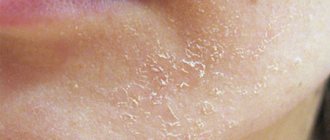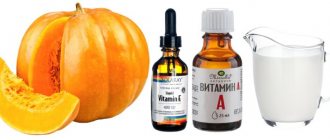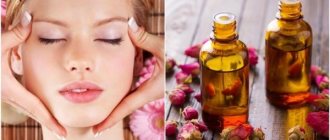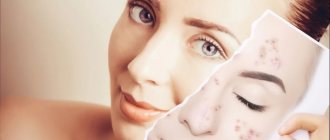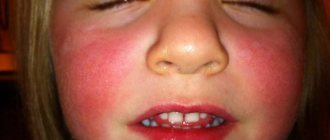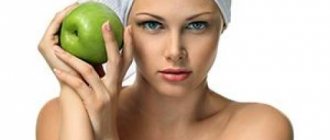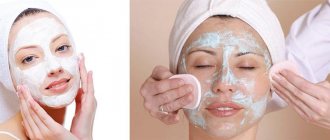Why does redness occur on the face?
The skin is the largest organ of the human body: its area ranges from 1.5–2.3 m2. It is a durable multi-layer elastic cover that performs a huge number of functions. Among them:
- protection of internal organs from damage, penetration of microorganisms, chemicals;
- preventing dehydration;
- participation in breathing, thermoregulation, metabolic processes;
- touch through nerve endings;
- removal from the body in sweat of toxins and waste products of the body (excess salts, ammonia, urea);
- secretion of sebum (secretory function), which ensures the elasticity of the epidermis and creates a protective environment on its surface;
- participation in the production of vitamin D.
The skin consists of three layers - epidermis, dermis and hypodermis. The epidermis is the upper layer visible to the eye, consisting of five layers. Its thickness ranges from 0.5 mm on the eyelids to 1.5 mm on the palms. The cells of the lower layer of the epidermis continuously divide, responsible for the rapid renewal, restoration, and healing of the skin. After division they begin to move upward.
As you progress, the amount of keratin and other dense proteins in the skin cells increases, and the division process slows down. The top layer consists of dead, keratinized cells that are continuously exfoliated. Using this method, the skin of an adult is completely renewed within two months, and in a baby – in three days.
The middle layer is the dermis, with a thickness of 0.3 to 3 mm. It consists of connective tissue containing collagen, muscle fibers, and nerve endings. Veins, arteries, and capillaries run through this layer, through which nutrients enter the blood. This method provides nutrition not only to the dermis, but also to the epidermis, where there are no blood vessels.
The lowest layer is the hypodermis, known as subcutaneous fat. Its task is to protect internal organs from external damage. The thickness of the hypodermis ranges from 2 mm on the head to 10 cm on the buttocks. There are many vessels, nerve endings, sweat glands, ducts of the sebaceous glands, hair follicles (the place where hair originates).
The main causes of redness on the face are inflammation and dilation of blood vessels in the dermis or hypodermis under the influence of external or internal causes. Because of this, they begin to appear through the epidermis, giving the skin a red color. The color can range from pinkish to raspberry-burgundy, depending on the thickness of the top layer of skin and the reason that caused the color change. These can be both physiological and pathological factors.
Possible reasons
In order to understand what to do when the face is red, you need to find the reasons for this
condition. To do this, you need to seek help from a specialist who will conduct a comprehensive examination, the necessary specialized consultations and prescribe correct, adequate treatment. The reasons that lead to the fact that the face turns red can be divided into three large groups.
- Emotional, psychological problems, temperament type.
- Physiological conditions.
- Diseases of the skin and internal organs.
It should be clarified that physiological reasons are more typical for women than for men. This is due to the peculiarities of the female hormonal cycle, the passage of intense processes in the body of women throughout it. Fluctuations in the level of biologically active substances occur individually. The intensity of hormone release depends on the characteristics of the body, age, concomitant diseases, and genetic characteristics.
Emotional reasons
The type of temperament directly affects the body's response to external stimuli. These include:
- stressful situations, both positive and negative;
- climatic factors: cold, heat;
- physical exercise.
A red face in response to emotional stress is a sign of choleric or sanguine temperament types. The number of people with this type of emotional structure in aggregate prevails among both men and women. Moreover, it is precisely among choleric men that those who develop a red face as a reaction to emotional stress predominate.
The fact is that this is true redness, which develops in response to a stressful stimulus. Women are emotionally much more labile, but significant hyperemia of the facial skin in response to emotional stress is less common among them.
Redness of the face as a reaction to low or high ambient temperatures is, to one degree or another, common to all people. The brightness of the manifestation depends on individual characteristics, the proximity of the blood vessels of the skin to its surface.
Cold or hot weather causes a rush of blood to the surface of the face, since it is this area that is open to air. For men, the reaction of certain areas of the face is more typical, while for women, the skin of the face turns completely red.
Intense physical activity, running, lifting weights, heavy work with load - all these types of activities can also act as a cause of facial flushing. No one is surprised by the red face of an athlete during exercise or a worker doing hard physical work.
Physiological conditions
Why can a state of the body in which a pathologically red face be called physiological? Because this symptom is characteristic of menopausal changes in the body of women, known as hot flashes. When the blood rushes intensely to the face, a feeling of heat and sweating appears. This is a normal process of decline of reproductive function after the age of 45–50 years.
Also, facial redness may appear in pregnant women in the second or third trimester of pregnancy as a reaction to the load on the bloodstream. For men, perhaps, there are no physiological conditions that are characterized by such signs. The reasons lie in the absence of complex hormonal regulation cycles.
Conventionally, sunburn of the facial skin can be called a physiological cause. From prolonged or inadequate exposure to direct rays for the skin type, the skin turns red, may hurt, local hyperthermia is felt, and peeling gradually begins.
Diseases of internal organs
Facial redness is a common sign of hypertension. Why is this happening? With high blood pressure, the vascular wall is tense and in good shape. Blood presses forcefully on the walls of large vessels and small skin capillaries from the inside. Where the vascular bed is located close to the surface of the skin or the epidermis is thinner, redness is noticeable.
Most often, such a place on the human body is the face. This is why hypertensive patients often have a reddened face. This applies to men equally to women; the differences here are only in the individual characteristics of the skin.
With a disease of the gastrointestinal tract, in particular the liver, hepatic erythema develops - redness of the face in the cheeks and forehead. It is for liver problems that an increase in the vascular pattern of the upper body is characteristic,
and the skin of the face is most permeated with blood vessels compared to other areas. The causes of liver diseases can be different:
- insufficiency of the enzyme apparatus;
- injury or surgery;
- alcoholism, drug addiction, smoking;
- viral infections - hepatitis;
- toxic damage to the liver tissue of chemical and radiation origin.
A lack of liver enzymes can be genetically determined or caused by chronic alcohol intoxication, which is more common in men. Injuries or surgical interventions that lead to limited liver function may be associated with tumor processes and helminthic lesions of the liver tissue.
Alcoholism and other social poisonings are also quite common causes of liver malfunction, and as a result, facial redness is quite pronounced.
Viral hepatitis affects the tissue so deeply that it almost always leads to cirrhosis of the liver over time, the blood stagnates, and the redness of the face intensifies. Acute poisoning or radiation exposure as a cause of liver damage is not very common, but if there is redness of the face, this factor cannot be excluded during diagnosis.
Allergic manifestations of rejection of any product or medication can also manifest as facial skin flushing.
Skin diseases
Acne lesions of the facial skin, inflammatory processes, rosacea - all these are external causes of facial skin hyperemia. This is typical for both men and women. It is known that one of the main signs of the inflammatory process is redness of the affected tissue and areas around the lesion. Therefore, a red face is a characteristic symptom of skin problems in this part of the body.
The skin here is the most sensitive, often exposed to mechanical, physical stress, and unfavorable climatic factors. It is no wonder that infection of the superficial and then deep layers of the epidermis of the facial skin leads to inflammation and redness of the entire surface or individual areas.
Over time, improperly treated or neglected processes tend to merge, the surface of the inflammation increases, and it seems that the whole face is red.
Causes of facial redness
Wind, low temperature, smoking, alcoholic drinks, stress, hard work, vigorous massage - these are the physiological causes of redness. They are a normal response of the body to the influence of factors unfavorable to the epidermis and subcutaneous vessels. Unlike pathological causes, they are never accompanied by dryness, itching, or peeling; nevertheless, a burning sensation may appear: for example, when a person finds himself in a warm room after a severe frost.
- How to learn to draw with a pencil - 6 tips for beginners
- Blisters on fingers
- Kefir pie in the oven: simple and delicious recipes
The causes of pathological redness include situations that cannot be explained by the natural nature of their origin, since they provoke the development of reactions in the skin that are characteristic of inflammatory processes. This condition may be accompanied by burning, itching, peeling and other unpleasant sensations. Pathological redness on the face can be caused by the following reasons:
- allergy;
- infection;
- inflammation;
- vascular pathologies;
- diseases of internal organs;
- mental illness.
It is not always easy to distinguish the physiological nature of redness from the pathological one. You can focus on the following symptoms:
- With physiological redness, the colored area does not have a clear boundary. The redness simultaneously covers the cheeks, nose, forehead, chin, gradually turning into a natural color. If the cause is a mechanical effect (rubbing the skin in a certain area), only the area subjected to stress turns red.
- With pathological redness, the colored area has smooth boundaries and often covers a certain area (only the nose, cheeks, etc.). At first, the color is slightly pronounced, over time it acquires a more intense color, does not go away until the provoking factor is eliminated, but even after this, traces may remain.
- With a physiological nature, the skin turns red quickly, the severity of the color does not increase. When the effect of the provoking factor ends, the redness disappears without a trace, without causing negative consequences.
Physical factors
There are many reasons not related to pathological processes in the body that can provoke temporary dilation of blood vessels on the face. These include:
- external temperature - cold, heat, ice or hot water;
- strong wind;
- intense friction - massage, rubbing, vigorous rubbing of cream, scrub, and other cosmetics;
- sunburn;
- prolonged exposure to dust on the skin;
- strenuous work or vigorous exercise;
- long stay in a position where the head is below the waist (weeding cities);
- injuries, burns.
Psycho-emotional
Expansion of blood vessels can be provoked by psycho-emotional factors. It can be:
- any strong feelings - fear, shame, joy, excitement, emotional stress, joy;
- anxiety before important events (speaking in front of an audience, interview, important conversation);
- stress;
- depression;
- feeling of self-doubt;
- complexes, fears, psychological barriers.
Blushing syndrome may develop under the influence of exciting or stressful factors. This condition is characterized by redness of the face in any exciting circumstances. Redness covers the skin in spots and does not go away for a long time. In such situations, a person often feels discomfort because he understands that his anxiety is noticeable to others. The cause of blushing syndrome is the overactive functioning of the sympathetic nervous system, which causes the blood vessels on the face to dilate not only in severe stressful situations, but also in slight excitement.
Medications for blushing syndrome are ineffective because they are unable to affect the ability of the sympathetic nervous system to respond to various factors. Treatment in this case involves surgery: during the procedure, a clip is applied to the nerve through which the brain orders the vessels of the face to expand, or it is even cut. The method is effective in 95% of cases.
Allergic reaction
Vasodilation can provoke an allergic reaction. This is the name given to the immune system’s response to a specific irritant (allergen), which it perceived as a threat to the health and life of the owner. Anything can provoke such a reaction:
- pollen, fluff;
- dust mites, cockroaches;
- pet hair;
- mold;
- medicines;
- food products - nuts, eggs, seafood, milk, legumes, citrus fruits, etc.;
- insect bites.
Among the manifestations of allergies are redness of the facial skin, accompanied by itching and swelling. A symptom of an allergic reaction is dermatitis - inflammation of the skin, manifested by a rash, pimples, blisters, pustules (pustules), cracks through which infection can easily penetrate. Allergies are dangerous because they rarely go away on their own, and if the allergen is not eliminated, it can cause anaphylactic shock and death. As soon as the irritant is eliminated, the allergic reaction disappears, the redness completely disappears.
Infectious diseases
Redness of the skin on the face in women can be caused by infectious diseases. Among them:
- Cold or flu. Under the influence of high temperature, the blood vessels dilate, which leads to the appearance of a blush;
- Demodecosis. Chronic disease with periods of exacerbation. It is characterized by the penetration of a tick into the skin, the waste products of which lead to an allergic reaction. Demodicosis is manifested by itching, swelling, redness of the eyelids, and the appearance of scales around the eyelashes.
- Erysipelas or erysipelas. The reason is the penetration of beta-hemolytic streptococcus group A under the skin. The onset of the disease is acute, the symptoms of intoxication are pronounced - migraine, weakness, chills, nausea, high fever, swelling and thickening of the skin. Complications include necrosis and ulcers. The disease is prone to relapse, especially if left untreated. Treatment of the disease involves the use of antibiotics.
- Acne vulgaris or acne. Chronic inflammation of the skin, during which the sebaceous glands at the base of the hair follicle become blocked, which leads to the formation of comedones in the form of black and white formations, pustules, and redness at the site of inflammation.
- Fungal infections. Among them are trichophytosis and microsporia, collectively known as ringworm. Trichophytosis is characterized by reddish round spots that are very itchy and itchy, affecting the hair roots, which causes baldness. A symptom of microsporia is round or oval, clearly defined red spots with peeling. The fungus also affects hair, eyebrows, and eyelashes, causing the hair shafts to break off at a height of 5-6 mm.
- Measles, scarlet fever, chickenpox are acute infectious diseases characterized by high fever and a red itchy rash.
Inflammatory processes
The cause of redness may be inflammation, which develops after the immune system reacts to the penetration of a certain parasite into the body and sends white blood cells to destroy it. If immune cells cannot cope with the pathogen, they die, forming pus, attracting new leukocytes to the site of the lesion. Various situations can provoke inflammation on the face. Among them:
- Reaction to low-quality or incorrectly selected cosmetics.
- Skin contact with chemicals.
- Acne.
- Skin diseases - psoriasis, dermatitis, eczema.
- Photosensitivity is increased sensitivity to ultraviolet radiation caused by medications, laser hair removal, or other procedures. When the skin is exposed to sunlight, inflammation develops, accompanied by redness, swelling, and itching. After stopping the medication, the body stops reacting to the sun.
Pathologies of internal organs
In diseases of the internal organs, redness is often permanent and does not disappear until complete healing. In this situation, dilation of capillaries is a symptom of pathology, and to eliminate it it is necessary to treat the underlying disease. The complexion can be either pinkish or dark cherry, depending on the stage of the disease. Changes in skin color can provoke the following pathologies:
- high body temperature, regardless of the cause of facial redness in women, men, children;
- menopause;
- diabetes;
- atherosclerosis (deposition of cholesterol plaques on the walls of blood vessels);
- hypertension, heart failure, other pathologies associated with myocardial function;
- low acidity of gastric juice;
- frequent constipation;
- trigeminal nerve injury;
- medication use;
- chronic diseases of the ear, nose and throat (rhinitis, sinusitis, etc.);
- gynecological problems;
- parasitic diseases;
- problems of the digestive tract (cholecystitis, gastritis, kidney failure, cirrhosis);
- alcohol and drug poisoning;
- autoimmune diseases (systemic lupus erythematosus);
- erythrocytosis (pathological increase in red blood cells in the blood).
- Methods of home rehabilitation after ischemic and hemorrhagic stroke
- Endocrinologist - who is he and what does he treat? An endocrinologist will help with diseases of the endocrine system
- How to cook kharcho soup
Vessels
Vascular diseases can provoke redness, among them rosacea. It is characterized by the high sensitivity of blood vessels to changes in temperature, wind, heat, cold and other environmental factors that negatively affect the epidermis. In response to such exposure, the skin turns very red, the color remains for a long time even after getting into comfortable conditions, and is accompanied by a burning sensation. With rosacea, rosacea may appear, and thickening of the nose with the formation of nodules (papules) or bumps may occur.
The cause of persistent redness is rosacea, characterized by dilation of the blood vessels of the skin, which causes their elasticity to be lost. The capillaries are clearly visible in the form of a mesh. The pathology can be triggered by a long stay on the street under unfavorable conditions (working in winter) or internal pathologies, including hypertension, cirrhosis, gastritis.
Rosacea and rosacea are not the only vascular pathologies that can cause redness. It is worth highlighting such diseases as:
- skin hemangioma is a benign tumor of blood vessels, often manifests itself in the form of a node of capillaries closely adjacent to each other, and can protrude above the surface of the epidermis;
- Kasabach-Meritt syndrome - occurs in the first year of life, characterized by hemangiomas, anemia, and a low platelet count;
- Klippel-Trenaunay-Weber syndrome is a hereditary disease accompanied by a birthmark, hypertrophy of bones and soft tissues, varicose veins;
- Osler-Rendu disease is a hereditary pathology characterized by numerous spider veins on the face that bleed;
- Louis-Bar syndrome - manifested by capillary “stars”, impaired coordination, low immunity.
Causes
There are many reasons why your face may turn red. In this case, a rush of blood to the cheeks is usually felt. Only a doctor after an appropriate examination will help you determine the cause. But you shouldn’t delay your visit, because redness can indicate either a harmless allergic reaction or the presence of serious diseases. The causes of facial redness can be psychological and physiological.
To do this, answer 15 short questions and find out the possible causes and treatment options for your skin rash. A common cause of skin rash on the chest is seborrheic dermatitis, which also affects the scalp and face. This results in a skin rash with red papules, yellowish scales and severe itching. The cause of the disease is unclear, but tight clothing, oily skin and sweating can cause the disease. Patients get sick more than women. In addition, a person can come to the neck braid, which is designated in technical language.
Dangerous signs of facial redness
This rash is brownish and patchy and can cause dandruff and itching. In sunlight, the underlying skin does not light up, so the spots appear lighter than the surrounding surrounding skin. Another cause of skin rash on the chest in humans is psoriasis. Characteristic - small, tame, sharply defined, round, red spots with strong scaling. These spots may also occur on the back, head, or knees and elbows. Psoriasis can also lead to joint inflammation and changes in the nails.
Psychological ones include:
- Emotional tension, stress.
- Great excitement.
- Psychological barriers.
- Shyness, low self-esteem.
Redness occurs due to dilation of blood vessels and increased blood flow to the facial skin. It is difficult to say why, due to psychological factors, blood rushes to the face, because the capabilities of the human brain have not been fully studied. There is even such a disease as erythrophobia - the fear of involuntarily blushing. People exposed to it are constantly under stress and lack self-confidence. Frequent redness of the face due to the influence of psychological factors is called blushing syndrome. The following are physiological causes that can cause facial flushing.
Babies can suffer from what is called seborrheic eczema, a skin rash that, in addition to the chest, also affects the head and face and is associated with scaling. Often infants are younger than three months. The rash may be itchy and may also be attacked by bacteria. This skin rash usually heals in a short time in infants.
Another skin rash that can affect the breasts is called warmth, which is also sweating. The rash may also affect the face, armpits, and shoulder near the chest. Small blisters or pustules are typical. Heat peaks occur when the outside temperature is very high and the baby sweats profusely. Since sweat glands are still small in babies, they become more easily clogged.
Drug blushing syndrome
The face turns red after taking certain medications for a long time.
After taking certain groups of medications, facial redness occurs with a feeling of blood rushing to the cheeks. Typically, this effect is provided by drugs prescribed for the treatment of diabetes mellitus, breast cancer, ischemic heart disease, osteoporosis, bone pathology, ischemic and hypertension diseases. The redness goes away after stopping the medications.
Skin rash during pregnancy
As with a child, it may also be a rash on the child's skin due to infectious diseases, such as measles or rubella. This results in brownish patches that remain brighter in sunlight compared to the remaining tanned skin. This infection mainly occurs in people who are very sweaty, which can be caused by pregnancy. But other pelvic infections can be stimulated by this moist-warm environment and produce a rash with accompanying itching. However, during pregnancy, itching may occur without any obvious cause as the body reacts more sensitively to scents and chemicals.
Carcinoid syndrome
Redness of the face is accompanied by a feeling of blood rushing to the cheeks. This cause is the most dangerous because it is caused by serotonin-producing tumors. Typically these are tumors of the gastrointestinal tract and bronchi. The face turns red due to the periodic release of serotonin and serotonin-like compounds into the blood, which have a pronounced vasodilating effect. If, along with redness, you have low blood pressure and diarrhea, be examined by an oncologist.
However, this should go away on its own after a few days. If a skin rash on the chest during pregnancy is accompanied by general symptoms such as fever and sore throat, a doctor should be contacted immediately to rule out an infection that is harming the unborn baby. Here too the eruption is unclear and the patient suffers from general symptoms. Here small spots of eruption merge with each other. These two diseases can be confused with rubella, which is caused by the rubella virus.
Salon treatments against red face
In addition to the red, blotchy skin rash, fever and swollen lymph nodes may occur. In addition, diseases caused by tropical pathogens, such as dengue fever or malaria, can lead to measles rash. Another skin rash that can affect the strain is drug eruption, which causes an allergic reaction to the drug or anxiety, an allergic skin reaction caused by various reasons associated with sudden red spots and whistling burns, as well as severe itching.
This is a disease in which the vessels on the face sharply dilate and spasm occurs. In this case, the appearance and redness of the forehead, cheeks, and nose are observed. The eyes are often affected. Rosacea occurs mainly in mature women, and if it affects men (mainly those with fair skin), it is accompanied by serious complications.
Skin rash on chest and back
This yeast is a healthy part of all people.
Brownish spots are formed that remain brighter due to sun exposure compared to the surrounding skin. This fungus is not contagious and the disease is harmless. Another cause of skin rashes on the chest and back can be seborrheic eczema, which can lead to dandruff and itching, as well as a reddish rash that often also affects the scalp, surrounding areas and face. This can lead to cosmetic problems as well as bacterial colonization of the affected skin. The nature of the disease is not fully understood. It is known that heredity, disruptions in the immune system, gastrointestinal and endocrine diseases play an important role; the occurrence of the disease is often caused by the presence of a subcutaneous mite. It is not infectious and occurs in a chronic form. You can get rid of the symptoms of rosacea by applying medications to the skin and taking antibiotics.
Infections with chickenpox, measles, or tropical pathogens can also cause skin rashes on the chest and back. One that can occur in people with weakened immune systems can also affect the chest and back. The pathogen is the varicella zoster virus, which causes chickenpox and can then remain in the nerves and can be reactivated in cases of immune deficiency.
Skin rash on chest and arms
The skin rash usually follows a dermatome, which corresponds to the area of skin of the inflamed, infected nerve. If the chest and arms are affected by a skin rash, it may be neurodermatitis, also called atopic eczema in the technical language. This skin rash is red, dry, scaly and itchy, but not contagious. Children are often affected, and the disease “grows” with age. In many cases, people with atopic dermatitis also have allergies such as hay fever or suffer from asthma. Another common disease is psoriasis.
Hypertension
Increased blood pressure can also cause facial flushing. At the same time, the vessels of the whole body, including the face, experience tension and stress. This, in turn, leads to redness of the skin. After the pressure normalizes, the redness goes away.
Red spotted plaques with yellowish scales form. Other places where psoriasis can occur is on the scalp or on the knees, but also on the back. In some cases, affected patients also have joint complaints. Also in the context of an allergic reaction to a drug, a skin rash called drug eruption may occur, which begins on the trunk of the body and then spreads and is characterized by many small red spots and papules, similar to measles.
Typically, the mucous membranes are also affected, and often antibiotics such as sulfonamides or painkillers are triggers. We twitch and burp together to understand the cause and prepare for possible defense or flight. The shock of the unexpected sound literally brought us to all our limbs. We are trembling, our hearts are racing - and our face is suddenly white.
Systemic lupus erythematosus
The disease is accompanied by redness of the face, usually the cheeks. Externally, the spots look like butterfly wings. In this case, the red border of the lips and the oral mucosa are also affected. Women aged 20-40 years are usually susceptible to the disease, and the etiology of lupus is not completely clear. Currently, the disease is classified as autoimmune and rheumatic.
In an anxious or scary situation, the sympathetic response is activated. It is part of the autonomic, therefore unconscious, nervous system. The stress hormone norepinephrine causes the blood vessels in the skin to contract, causing the skin to bleed less. This activates the body, on the one hand, blood reserves for the muscles, as well as for the organs responsible for stopping and fighting. Then they can be better supplied with oxygen and nutrients.
Dermatitis, eczema, other diseases
In addition, possible blood loss from superficial injuries is minimized and the skin is cooled. Thus, the body is already prepared and pre-cooled for the expected, hot efforts of fight and flight. On the outside, you can see decreased skin circulation through a pale complexion—we are “pale with terror.”
Lupus erythematosus can occur due to genetic predisposition, after exposure to ultraviolet radiation, as a result of taking certain medications, as well as due to endocrine system disorders and chronic diseases. The disease provokes inflammation of the muscles and joints; in addition to redness, victims may experience a rise in body temperature. Systemic lupus erythematosus affects the joints, heart, kidneys and other organs. The mucous membrane of the palate, gums and cheeks is covered with edematous spots. It is treated exclusively with medication.
Redness has a completely opposite cause. “From a purely medical point of view, our blushing occurs because the blood vessels dilate,” explains Doris Wolf, a psychologist and author from Mannheim. “This is because our brain sends out hormones and our blood pressure increases.” The enlargement of blood vessels causes us to cool down and maintain a constant temperature in the body. Blushing is a normal, healthy reaction that we can provoke in ourselves, such as in the sauna or hanging our heads.
When we talk about blushing, we do not mean, of course, rotting in the sauna, but a sudden blush in the presence of others, we mean a red head, which makes our uncertainty or embarrassment visible outward, explains the psychologist. We call this blushing ourselves unconsciously. This is expressed in many people by a bright head. Unlike lethargy, the body does not prepare to fly or fight in such a situation.
Influence of external factors
The body may respond to changes in external conditions by redness of the skin. Wind, sun, temperature changes, physical activity and other similar factors provoke dilation of blood vessels and a rush of blood to the skin. In this way, the body regulates heat exchange for normal functioning. In this case, the redness goes away as the body returns to its usual environment.
Rather, the brain is more perfused because it is trying to find a way out of the situation. Flushing is unpleasant for many people because it allows the opposite to read the feelings from the face. Many suffer from redness, says Wolf. Victims often fall into the circle of the devil. “They start to judge themselves for blushing, and they constantly worry about turning red.” Result: the more often each person is worried about himself, the more often this happens. We begin to avoid situations where we might become red and red in more and more situations.
Allergy
Due to external or internal contact with the irritant, red spots may appear on the skin. Allergies often manifest as redness on the cheeks. Usually the symptom goes away after stopping contact with the allergen. In this case, the irritant can be anything to which your body is sensitive - feathers, fluff, food, household chemicals, and other substances.
The result is often social isolation, Wolf explains. Thus, the victims were very sensitive when reacting to their blushing and consciously avoided situations in which they blushed. Particularly influential are perfectionists who want to love everyone and at the same time have low self-confidence.
For those who may be flushed, simple therapy can help. To reduce your fear of blushing, you need to learn not to view rotting as a disaster, but as an irritating but irreversible reaction of the body, explains Wolf. The more confident you are in dealing with blushing, the more relaxed you are in reacting.
Alcohol and smoking
Blood vessels dilate when eating the wrong foods - hot, salty, spicy. A similar effect is also observed when drinking strong drinks. But when smoking, the amount of oxygen in the blood decreases; in other words, your skin begins to suffocate, which leads to redness of the skin. In the future, this can lead to the development of a red vascular network appearing on the face. It is worth noting that it is completely impossible to get rid of rosacea.
Actinic keratoses. What is actinic keratosis? Actinic keratoses form due to abnormal cells that are limited to the top layer of the skin. Actinic keratoses usually develop on areas of the skin that are exposed to the sun, such as the face, scalp, ears, arms and hands. They are red, scaly areas that feel rough to the touch.
Who is at risk of getting actinic keratoses and how often does it happen? Actinic keratoses often occur in people who. Light skin was exposed earlier in life, most of the sun over 45 are men, consistent with more men engaging in outdoor activities. But women are just as likely to suffer from actinic keratosis as men, especially when they are older and take oral transplant medications. What causes activating keratosis and how does it develop?
If redness is accompanied by peeling and itching, or other unpleasant symptoms, consult a dermatologist. You may be developing a skin disease, such as eczema or demodicosis. In this case, it will be necessary not only to find the irritant that provoked the symptoms, but also to exclude internal diseases, as well as undergo a course of drug treatment.
There are some known factors that cause actinic keratosis. The most important factor is probably the individual's genetically determined skin type. Vibrant skin coupled with chronic and excessive sun exposure is the main cause of actinic keratosis. This results in a change in the genetic code, which then turns normal cells into abnormal or atypical cells. Step by step, these abnormal cells replace the normal epidermis and lead to disruption of the keratinization process of the skin.
Actinic keratoses can also be caused by exposure to carcinogens such as. How to detect actinic keratosis. The body being examined should be carefully examined by a dermatologist. Actinic keratoses can often be felt rather than seen. Because actinic keratoses resemble other skin diseases and cannot always be distinguished from squamous cell carcinoma, sometimes part of the skin must be removed for further examination.
Wrong cosmetics
Often the cause of facial redness is the use of cosmetics that are not suitable for a particular skin type. And since cosmetics come into direct contact with the skin, the risk of developing allergic reactions is very high. Failure to follow the rules of skin care and the body as a whole also affects its condition. The result is early wrinkles, sagging, redness.
Menopause
During menopause (menopause), so-called hot flashes are observed. During a hot flash, a woman feels intense heat in the upper body, including on the face, redness of the skin, difficulty breathing, increased heart rate, dizziness, nausea and weakness, and increased sweating. Hot flashes occur due to a sharp change in hormonal levels, when the body's thermoregulation is disrupted.
Such processes last from a few seconds to a couple of minutes and can occur either about 8 times a day or more than 20. Moreover, they are accompanied by dilation and constriction of blood vessels, which leads to redness of the skin. You can minimize the frequency of hot flashes by following a healthy lifestyle, taking sedatives and hormone replacement drugs, and using traditional medicine recipes.
In addition to the above reasons, facial redness can occur due to other factors: long-term use of antibiotics, minor injuries to the skin or blood vessels, thermal procedures, pregnancy, etc. For an accurate diagnosis, consult a specialist. At the same time, try to adhere to a healthy lifestyle, sleep at least 8 hours a day, and avoid stress and physical overload.
Pathologies, diseases, conditions of the body as the causes of facial skin hyperemia. Diagnostics, therapeutic, cosmetological care, preventive measures.
Normal, healthy facial skin makes you feel beautiful and attractive to others. Any skin problem on a part of the body, which, no matter how hard you try, cannot be hidden from others, causes a lot of trouble and trouble. Pimples, wounds, freckles, birthmarks - all these defects lead to the appearance of psychological complexes in their owners. A red face is quite common. Redness (hyperemia) of the facial skin can be both a cosmetic problem and a signal of a disease of the internal organs, an imbalance in the body’s homeostasis, or a lack of nutrients in the diet. Why does the skin of the face turn red, how quickly does it go away or is it constant - all these questions need to be answered.
Types of redness on the face
The shape of spots on the face largely depends on the reason that provoked the change in skin color. It could be:
- Redness on the forehead and cheeks, gradually turning into the natural color of the skin, is characterized by rapid disappearance in comfortable conditions. Provoked by physiological reasons.
- Inflammation accompanied by acne.
- A soap rash is a symptom of an allergy.
- Exudative form - spots of various shapes appear on the skin, in place of which bubbles and ulcers form. The formations itch, hurt, and are often accompanied by fever. The reason for their appearance is viruses, staphylococci, streptococci, and sometimes antibiotics and anticonvulsants.
- The nodular form is red rashes in the form of dense, round, painful formations. Sizes range from small rashes to large formations, up to 10 cm in diameter. The reason is viruses.
- Ring-shaped - spots of different sizes with a clearly colored edge. Signals a bacterial or fungal infection, allergy or autoimmune disease.
- Migratory form. The spots occur where ticks or insects have bitten them if they carry diseases (such as Lyme). After some time, the irritation may move away from the bite site, growing in size. If you find such a spot, you should urgently consult a doctor.
Accompanying symptoms
Red spots are often accompanied by symptoms that help determine the cause of the change in complexion. It can be:
- Peeling. Signals increased sensitivity to weather conditions, low-quality cosmetics, and vitamin deficiency. It occurs with demodicosis, fungal and skin diseases, and damage to internal organs.
- Itching. A symptom characteristic of allergic reactions. Accompanies measles, rubella, scarlet fever. If it is combined with peeling, dryness or lasts more than 20 days, it indicates a skin disease.
- Burning. It happens with allergies, rosacea, it develops during a long stay in conditions unfavorable for the skin, due to a sharp dilation of blood vessels, a long stay with the head bowed low, after strong physical exertion, and emotional stress.
- Redness around the nose is a symptom of gastrointestinal diseases or perioral dermatitis.
Climax
Everything is clear here. Tides. They are associated with a natural decrease in estrogen levels in the blood. There may be a feeling of heat with sweating and redness of the face.
This happens in 50–80% of women over 45 years of age.
If the reason was surgical removal of the ovaries, then all this manifests itself much brighter and stronger.
Hot flashes can last 3–5 minutes and occur up to 20 times a day. They interfere with sleep and significantly spoil life.
The idea is that when the level of estrogen in the blood decreases, the internal thermostat is reconfigured. But exactly how this happens is not entirely clear.
Treatment for redness on the face
Red spots can be removed using etiotropic or symptomatic therapy. The first option is aimed at eliminating the cause of redness. If this is a pathology of internal organs, it is necessary to begin treatment. In this case, the disappearance of redness will indicate recovery. If the cause is a psychological factor, it is necessary to undergo a course of psychotherapy or do exercises aimed at stabilizing the nervous system. You can reduce the aggressive effects of the external environment using protective cosmetics.
Symptomatic treatment is aimed at reducing the intensity of redness. This method is resorted to if it is not possible to get rid of the pathological cause, so the effect does not last long. For this purpose, they use special cosmetics, aloe juice, and resort to washing with cold water.
Skin care rules and nutrition
You can avoid red spots on the face and reduce the severity of their manifestation with the help of proper nutrition and proper skin care. For this purpose, you must perform the following actions:
- wash only with warm water, the temperature of which ranges from 32–34 °C;
- Do not rub your face with a towel after washing, but gently blot it with napkins;
- Apply cream, tonic and other cosmetics with light patting movements, avoiding vigorous rubbing;
- do not sit in a hot bath for a long time, refuse baths and saunas;
- do not apply hot masks to your face;
- Avoid using aggressive scrubs, alcohol lotions, scented gels and soaps;
- to clean the epidermis and remove makeup, use soft, fragrance-free preparations;
- Apply a high-quality moisturizer to the skin in the morning, and a nourishing cream in the evening after cleansing;
- stop smoking;
- if necessary, you can use a concealer (special corrector) to mask the redness.
Human health largely depends on the food he eats. After food is digested in the digestive tract, the elements released from it enter the blood and participate in metabolic processes. For this reason, low-quality products cause harm to the body, including harm to the skin, causing a response on its part in the form of redness, rash, and itching. To avoid such manifestations, it is necessary to exclude from the diet or significantly limit the use of:
- strong tea;
- coffee;
- alcohol;
- fried, sweet, spicy foods;
- spicy food;
- baking;
- sweets, chocolate;
- fast food.
Salon treatments
Salon procedures will help eliminate facial redness. To this end, the following measures are resorted to:
- superficial chemical peeling, which removes the top layer of the epidermis;
- cryomassage - a treatment method that involves combining the effects of cold on the skin with massage movements;
- mechanical cleansing and masks - help get rid of acne, inflammation, peeling;
- laser therapy or electrocoagulation – eliminates spider veins from the skin;
- mesotherapy - exposure to the middle layer of the dermis with active substances;
- biorevitalization – saturation of the deep layers of the skin with nutrients (drugs are administered by injection).
If redness is caused by pathologies of internal organs, the effect of salon procedures will be short-lived. How long it will last depends on the cause of skin coloring, general health, care of the epidermis, and the presence of chronic diseases.
Pharmacy products
You can get rid of redness using pharmaceutical ointments. Among them, the following drugs are worth highlighting:
- Fenistil-Gel – relieves swelling, irritation, itching;
- Gistan – eliminates irritation;
- Boromenthol – characterized by a cooling effect, refreshes the skin, relieves redness and itching;
- creams of the Quasix group - relieve redness, inflammation, are effective for demodicosis and rosacea;
- Troxevasin - narrows and strengthens blood vessels;
- Naphthyzin is a vasoconstrictor;
- Boro Plus - relieves acne, pimples, dryness, flaking, softens and moisturizes the skin, relieves redness;
- Bepanten - promotes tissue restoration and regeneration, regulates cellular metabolism, maintains collagen levels, eliminates inflammation.
Folk recipes
Folk remedies will help eliminate redness. To get the effect of their use, a course of 8–10 procedures is required. You can prepare an effective remedy for facial redness using one of the following recipes:
- Mix chopped parsley with sour cream. Apply the mixture evenly to the face, leave for a quarter of an hour, rinse with warm water. Apply the mask every other day.
- 2 tsp. mix fat cottage cheese with 1 tsp. vegetable oil, add five drops of grapefruit juice. Apply the mixture to your face, keep for 20 minutes, rinse with cool water. The mask can be done daily.
- Brew strong black tea and cool. Soak gauze in the infusion, apply to the face, and leave for half an hour. Such compresses can be done 1-2 times a day for a long time.
- Grate the potatoes, place the pulp in cheesecloth, and squeeze out the liquid. Wipe your face with potato juice after washing 2-3 times a day.
A steam bath with hops will help soothe inflamed skin and relieve redness. To do this, pour 15 g of chopped herbs into an enamel pan, add a liter of cold water, put on low heat, and bring to a boil. Remove from the stove, bend over the broth, cover your head with a blanket or terry towel. For those with dry skin, steam for 3-4 minutes, for oily skin – ten. After the procedure, apply moisturizing milk or cream to the epidermis.
The face turns red and burns: physiological reasons
A person's health condition can also lead to facial flushing and a feeling that not only the cheeks or ears are burning, but the whole head. In addition to the already mentioned allergic reaction (it can be caused not only by inappropriate cosmetics, but also by certain foods, medications, tobacco smoke, dust, pollen, etc.), you should keep in mind the following causes of redness of the skin:
- some internal diseases;
- menopause (with its hot flashes);
- pregnancy;
- drinking alcohol in large quantities;
- smoking, etc.
There are quite serious diseases, the symptoms of which include redness of the skin on the face. Among the diseases and conditions that cause redness of the epidermis, which leads to a burning face and head, the following can be identified as causes:
- problems related to the heart and blood supply to the skin of the face and other organs;
- arterial hypertension, which causes vasodilation when blood pressure increases;
- infectious diseases;
- lack or excess of vitamins in the body;
- non-infectious skin diseases, such as rosacea;
- metabolic disorders, as evidenced by the presence of chronic constipation and rare urination;
- intoxication, that is, poisoning of the body with various poisons and toxins;
- changes in hormonal levels, including those associated with pregnancy or menopause in women.
If a person has fairly thin skin, then the likelihood that his face will turn red when exposed to certain factors is much higher. By the way, heredity, that is, genetic reasons, can play a big role here.
If there is a hereditary predisposition to thin skin and frequent facial redness, then you need to carefully monitor your health, lifestyle, diet and carefully select cosmetics. For washing, you should use only warm water, do not stay in the sun for a long time, minimize alcohol consumption, and give up cigarettes. Among cosmetic products, it is recommended to choose those that do not contain ethanol. It is advisable to include a large amount of fresh fruits and vegetables in your daily menu. If the face nevertheless turns red and inflammation appears, then you can get rid of such manifestations with the help of herbal decoctions, for example, linden or chamomile.


